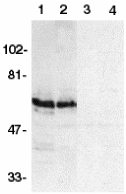Anti-SODD antibody (ab2048)
Key features and details
- Rabbit polyclonal to SODD
- Suitable for: ICC/IF, WB
- Reacts with: Human
- Isotype: IgG
Overview
-
Product name
Anti-SODD antibody
See all SODD primary antibodies -
Description
Rabbit polyclonal to SODD -
Host species
Rabbit -
Tested Applications & Species
See all applications and species dataApplication Species ICC/IF HumanWB Human -
Immunogen
Synthetic peptide corresponding to Human SODD aa 2-16.
Sequence:SALRRSGYGPSDGPSC
(Peptide available asab8382) -
Positive control
- HeLa whole cell lysate or THP-1 whole cell lysate.
-
General notes
SODDs.
Apoptosis is induced by certain cytokines including TNF and Fas ligand of the TNF family through their death domain containing receptors, TNF-R1 and Fas. Several novel death receptors including DR3, DR4, DR5, and DR6 were recently identified. Cell death signal is transduced by death domain containing adapter molecules through the interaction with death domain of these death receptors. A novel TNF-R1 interacting protein was recently identified and designated SODD for SODDs. SODD associates with the death domain of TNF-R1 and prevents constitutive activation of TNF-R1 signaling. TNF treatment releases SODD and permits adapter molecules such as TRADD recruiting to the active TNF-R1 complex, which activates TNF signaling pathways. SODD also interacts with DR3. SODD is ubiquitously expressed in human tissues and cell lines.
This product was previously labelled as Silencer of Death Domain
Properties
-
Form
Liquid -
Storage instructions
Shipped at 4°C. Upon delivery aliquot and store at -20°C or -80°C. Avoid repeated freeze / thaw cycles. -
Storage buffer
pH: 7.2
Preservative: 0.02% Sodium azide -
 Concentration information loading...
Concentration information loading... -
Purity
DEAE-Chromatography -
Purification notes
SODD Antibody is Antibody is DEAE purified. -
Primary antibody notes
Apoptosis is induced by certain cytokines including TNF and Fas ligand of the TNF family through their death domain containing receptors, TNF-R1 and Fas. Several novel death receptors including DR3, DR4, DR5, and DR6 were recently identified. Cell death signal is transduced by death domain containing adapter molecules through the interaction with death domain of these death receptors. A novel TNF-R1 interacting protein was recently identifiedand designated SODD for silencer of death domains. SODD associates with the death domain of TNF-R1 and prevents constitutive activation of TNF-R1 signaling. TNF treatment releases SODD and permits adapter molecules such as TRADD recruiting to the active TNF-R1 complex, which activates TNF signaling pathways. SODD also interacts with DR3. SODD is ubiquitously expressed in human tissues and cell lines. -
Clonality
Polyclonal -
Isotype
IgG -
Research areas
Images
-
All lanes : Anti-SODD antibody (ab2048) at 1/500 dilution
Lane 1 : HeLa whole cell lysate with absence of blocking peptide
Lane 2 : THP-1 whole cell lysate with absence of blocking peptide
Lane 3 : HeLa whole cell lysate with SODD peptide (ab8382)
Lane 4 : THP-1 whole cell lysate with SODD peptide (ab8382)
Observed band size: 60 kDa why is the actual band size different from the predicted?
-
ab2048 at 5µg/ml staining SODD in Hela cells by ICC/IF
-
Immunofluorescence of SODD in Hela cells using ab2048 at 20 ug/ml.














